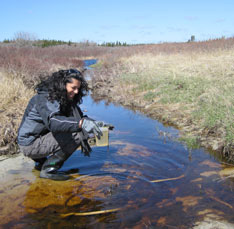
A major Canadian research project to commercialize mass production of biofuels from algae is under way in Halifax that will use carbon-dioxide emissions from fossil-fuel combustion to help the algae grow.
Science and Technology Minister Gary Goodyear announces the launch of the C$5 million ($4.7 million) National Research Council (NRC) algae biofuels project in Halifax.
The project is being funded through the National Bioproducts Program and National Research Council Institute for Marine Biosciences.
Preliminary work and engineering plans call for building a 13,200-gallon (50,000-L) cultivation pilot plant at the Ketch Harbor facility, 15 miles (24 km) south of Halifax.
Goodyear says biofuels produced from renewable resources such as algae are key to future energy sustainability and have the highest potential for carbon capture.
Some species of microalgae are expected to yield as much as 20 times more oil than traditional agricultural crops.
“As a renewable resource, algae are a clear winner – they don't require arable land, nor do they compete with food production,” Goodyear says in a statement. “These new fuels have the potential to deliver clean air, clean energy, clean water and economic benefits for Nova Scotians and all Canadians.”
Carbon2Algae Inc., an industrial partner in the effort, eventually plans to operate algae photobioreactors that will capture CO2 from facilities such as the Alberta oil sands or coal-fired power plants and use these emissions to allow local strains of algae to thrive.

The Canadian Press news service says the algae is a microscopic version of the green slime that fouls pools and fish tanks and could become huge pools of absorption for CO2.
The chemical reaction of the CO2, water and organisms produces oxygen, sugars, proteins and plant oils that can be used in engines for the transportation sector.
Researchers at the Marine Research Station in Ketch Harbor have been growing algae for more than 50 years.
In assessing how best to grow algae for biofuels, NRC has joined forces with the U.S. Department of Energy, the National Renewable Energy Laboratory in Colorado and Sandia National Laboratories in New Mexico.
The NRC says 64 species of algae have been collected and studied for the project, with 24 brought into cultivation and six under intensive scrutiny.
NRC researcher Stephen O'Leary predicts commercial production of algal biofuels is likely in another five to 10 years.
“We're asking plants to do what they do best,” he says. “With little more than water and carbon dioxide, algae can harvest sunlight and turn it into energy that could eventually be used to create jet fuel.”
O'Leary says the difficulty is coming up with a technology that can produce industrial-scale amounts of algae and convert it into massive quantities of plant oils that can be blended in transportation fuels.
“The main obstacles to commercialization are the scale of the technology,” he says. “We can grow microalgae in our lab; we can harvest the biomass and produce a fuel and demonstrate that it will burn in an engine. The difficulty is being able to do that at an industrially relevant scale.”
A key component distinguishing the NRC algal biofuels project from other international efforts is the focus on identifying local strains of algae suitable for biofuels production from specific sites in North America.
The local species already are acclimatized to the environment, making them easier to grow and avoiding the risks of importing foreign species that might accidentally be released into the environment.




